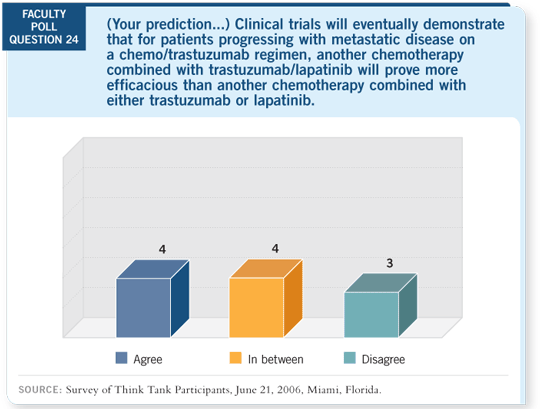

Select Excerpts from the Discussion
CD 2, Tracks 20-25
 DR LOVE: Chuck, can you review the results from the lapatinib trial you
presented at ASCO 2006?
DR LOVE: Chuck, can you review the results from the lapatinib trial you
presented at ASCO 2006?
 DR GEYER: This was a Phase III trial comparing the approved dose of
capecitabine as the control arm to the Phase I combination dose of 2,000
mg/m2 of capecitabine per day on days one to 14 of 21 days with 1,250 mg of
lapatinib per day continuously. The patient population included women with
breast cancer who had received prior anthracycline, taxane and trastuzumab
therapy. They were not allowed, however, to have received prior capecitabine
(Geyer 2006).
DR GEYER: This was a Phase III trial comparing the approved dose of
capecitabine as the control arm to the Phase I combination dose of 2,000
mg/m2 of capecitabine per day on days one to 14 of 21 days with 1,250 mg of
lapatinib per day continuously. The patient population included women with
breast cancer who had received prior anthracycline, taxane and trastuzumab
therapy. They were not allowed, however, to have received prior capecitabine
(Geyer 2006).
When the Independent Data Monitoring Committee (IDMC) reviewed the
data, they recommended early closure of the trial because the boundary had
been crossed for superiority. The median time to progression was improved
from about 4.5 to 8.5 months. The response rate was also increased from 14 to 22 percent, but it did not meet statistical significance (Geyer 2006).

An interest with lapatinib is the potential impact it might have in reducing
CNS events, and this was tracked. Numerically fewer — four versus 11
— CNS relapses were recorded in the lapatinib arm. But too few total events
occurred to make any definitive statement (Geyer 2006).
Toxicity was a concern because we saw overlapping toxicity. With the combination,
we saw overall increases in diarrhea, hand-foot syndrome and skin
rashes but virtually no Grade IV toxicities. The Grade III toxicities weren’t
appreciably different. So the concern about additive toxicity with lapatinib and
capecitabine wasn’t borne out (Geyer 2006).
Because of the cardiotoxicity issue with HER2 blockade, careful cardiac
monitoring was provided. Patients underwent scans every six weeks for the
first six months and then every 12 weeks. Conservative criteria were used to
define a cardiac event (Geyer 2006).
Patients who had symptomatic heart failure, obviously, would have been
considered as having an event. Also patients who had asymptomatic declines
with a relative decrease of more than 20 percent from baseline to below
normal were considered to have had an event. On the study, four cardiac
events occurred with lapatinib/capecitabine and one with capecitabine alone,
and all were asymptomatic (Geyer 2006).

 DR LOVE: Debu, what is your opinion of lapatinib and where it’s heading?
DR LOVE: Debu, what is your opinion of lapatinib and where it’s heading?
 DR TRIPATHY: It was interesting that this study showed almost a doubling of
time to disease progression without a concomitant increase in response rate
that was significantly different (Geyer 2006). I believe this is going to be a
very important drug in this population of patients.
DR TRIPATHY: It was interesting that this study showed almost a doubling of
time to disease progression without a concomitant increase in response rate
that was significantly different (Geyer 2006). I believe this is going to be a
very important drug in this population of patients.
One can extend this even further and ask whether it will delay time to disease
progression in patients with HER2-positive disease as up-front or adjuvant
therapy.
 DR WOLFF: One question posed after the presentation was whether this study
could indirectly be addressing a question we have been unable to answer: Is
the continuation of anti-HER2 therapy truly important for the patient whose
disease is progressing on first-line anti-HER2 therapy?
DR WOLFF: One question posed after the presentation was whether this study
could indirectly be addressing a question we have been unable to answer: Is
the continuation of anti-HER2 therapy truly important for the patient whose
disease is progressing on first-line anti-HER2 therapy?
The study that could never be done was for patients who were receiving
paclitaxel and trastuzumab, and at progression they were randomly assigned to
vinorelbine with trastuzumab or vinorelbine alone.
This study essentially asks, for the patient whose disease is progressing on
trastuzumab, is switching to another chemotherapy drug but continuing an
anti-HER2 therapy — in this case, lapatinib — better than not continuing the
targeted therapy?
The answer in this case is yes. How much of this is an effect of lapatinib itself,
as a drug that is active in patients whose disease has progressed on trastuzumab,
and how much of it is simply a continuation of anti-HER2 therapy?
 DR LOVE: Joyce, for a patient who experiences progression after receiving
adjuvant trastuzumab, would you reinstitute trastuzumab? How would you
factor in lapatinib if it were available?
DR LOVE: Joyce, for a patient who experiences progression after receiving
adjuvant trastuzumab, would you reinstitute trastuzumab? How would you
factor in lapatinib if it were available?
 DR O’SHAUGHNESSY: I haven’t had to cross that bridge yet, but I believe it
would depend on the disease-free interval. If it was very brief, I’d be inclined
to use lapatinib, but it’s important to find out whether we need trastuzumab to
maximize the effectiveness of lapatinib.
DR O’SHAUGHNESSY: I haven’t had to cross that bridge yet, but I believe it
would depend on the disease-free interval. If it was very brief, I’d be inclined
to use lapatinib, but it’s important to find out whether we need trastuzumab to
maximize the effectiveness of lapatinib.
If patients have had a decent disease-free interval, they obviously are
somewhat resistant to trastuzumab but they still may retain some sensitivity.
I believe the randomized trial being conducted of lapatinib alone versus
lapatinib with trastuzumab is very important.
 DR RUGO: That trial that Dr Geyer presented is interesting because it requires
that patients receive two prior chemotherapy regimens and trastuzumab for
metastatic disease. It’s not testing what to do if a patient has relapsed within a
year of adjuvant therapy.
DR RUGO: That trial that Dr Geyer presented is interesting because it requires
that patients receive two prior chemotherapy regimens and trastuzumab for
metastatic disease. It’s not testing what to do if a patient has relapsed within a
year of adjuvant therapy.
Another trial is testing the combination of trastuzumab and lapatinib with
paclitaxel, but the patients are not allowed to have relapsed on adjuvant trastuzumab.
They have to be off it. They are randomly assigned to paclitaxel/trastuzumab with or without lapatinib as first-line therapy.
All these trials are going on now, and we’re not going to have results for a
while. Right now we have to finalize the neoadjuvant and adjuvant trial
designs, which are incredibly controversial. Opinions vary tremendously.
 DR LOVE: Cliff, can you comment on some of the options that are being
discussed for the next generation of adjuvant trials for patients with HER2-
positive disease?
DR LOVE: Cliff, can you comment on some of the options that are being
discussed for the next generation of adjuvant trials for patients with HER2-
positive disease?
 DR HUDIS: The Aphrodite trial is currently written as one year of trastuzumab,
one year of lapatinib, one year of trastuzumab with lapatinib or a
sequence of trastuzumab for six months followed by lapatinib for six months.
The neo-Aphrodite trial tries to investigate the biology by administering
trastuzumab or lapatinib alone or the combination before surgery, following
with the remainder of a year of treatment.
DR HUDIS: The Aphrodite trial is currently written as one year of trastuzumab,
one year of lapatinib, one year of trastuzumab with lapatinib or a
sequence of trastuzumab for six months followed by lapatinib for six months.
The neo-Aphrodite trial tries to investigate the biology by administering
trastuzumab or lapatinib alone or the combination before surgery, following
with the remainder of a year of treatment.
In the cooperative groups, the North Central proposal that is currently being
worked on is built on the same themes of single-agent lapatinib versus single-agent
trastuzumab versus the combination. We have a preoperative proposal
matching that, which uses preoperative trastuzumab, lapatinib or the combination
along with weekly paclitaxel for a fixed period of time. It provides a
chance to observe the pathway markers and markers of resistance.
The big controversy is whether people are brave enough, as those planning the Aphrodite trial appear to be, to commit to a year of lapatinib without
any trastuzumab for a patient with HER2-positive, early-stage disease. That’s
either brilliant or a leap of faith.
 DR GEYER: The NSABP and the CIRG have agreed to work together on
our B-31 replacement and their BCIRG 006 replacement study, with the idea
of testing chemotherapy/trastuzumab with or without bevacizumab as the
question. We are waiting for more information from the pilot data to reach
consensus on some of the chemotherapy backbone issues, and we hope to have
the study out by the end of the year.
DR GEYER: The NSABP and the CIRG have agreed to work together on
our B-31 replacement and their BCIRG 006 replacement study, with the idea
of testing chemotherapy/trastuzumab with or without bevacizumab as the
question. We are waiting for more information from the pilot data to reach
consensus on some of the chemotherapy backbone issues, and we hope to have
the study out by the end of the year.
Select publications

